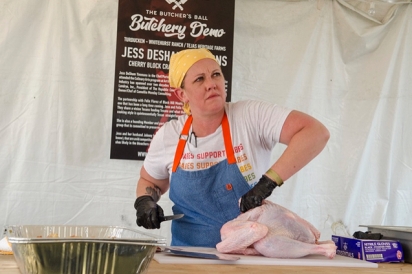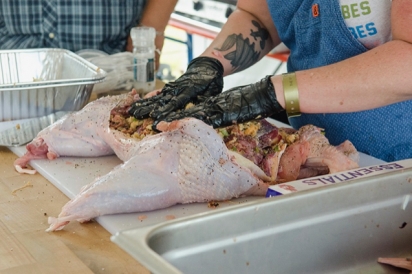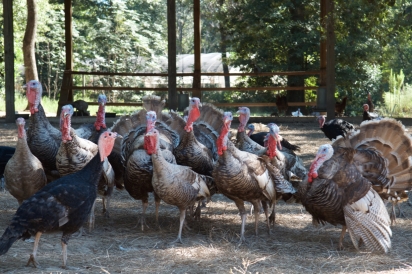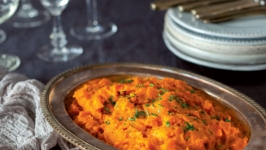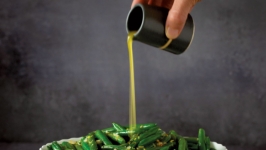Make A Turducken - Step by Step Instructions
There’s this video, a time lapse that shows a team of butchers at Black Hill Meats debone a whole hog. Led by chef and rancher Felix Florez, they carve out the rib cage, remove back and neck bones, slit open back legs to lift out all bones and do the same with the front legs. They work meticulously fast and efficient, carving intricately close to the bone so no meat is wasted.
It is spellbinding.
At the fourth annual Butcher’s Ball, held at the beautiful Rockin’ Star Ranch in Brenham, one of the butchers in that video, Chef Jessica DeSham Timmons of Cherryblock Butcher & Seasonal Kitchen, is in action again. She demonstrates how to debone a turkey for turducken. “Once you know your bird,” she says, “deboning a turkey isn’t any different from deboning a chicken.” For her, used to deboning whole hogs, turducken is child’s play anyway.
Turducken. For anyone not familiar with the culinary tradition in these parts of Texas and Louisiana, a turducken is a boneless turkey stuffed with a boneless duck stuffed with a boneless chicken. Packed in the cavities is a cornbread or rice dressing, popularly enriched with spicy sausage like andouille but oysters and crawfish are also common. The whole thing is baked until succulent and crisp-skinned.
Who came up with turducken is a matter of local opinion. Many credit Louisiana’s iconic chef Paul Prudhomme with its invention, in the 1970s. But engastration—a culinary technique of stuffing one animal inside another to cook—exists at least since the Middle Ages, and examples can be found the world over. Even in the arctic: In Greenland I learned about a traditional Inuit winter food known as kiviak, which is seal stuffed with whole, unplucked and head-on seabirds left to ferment. I’ll take turducken any day.
Chef Richard Knight of Atlas Diner HTX is in the same tent, looking on as Chef Timmons debones her turkey. Stuffing birds with birds is nothing new to Houston’s uncrowned king of nose-to-tail. He used to do as many as six birds, he tells me: “Turkey, duck, chicken, Cornish hen, poussin and quail, all deboned.” And he would add an anchovy-stuffed olive inside the smallest bird, a nod to Alexandre Dumas’ Anchovy Monte Cristo.
One of the most absurd engastration examples is perhaps the much-written about Rôti Sans Pareil, or “roast like no other”. It lists a mind boggling 17 birds, all stuffed one into the other. Rôti Sans Pareil sprang from the imagination of an early 1800s French gastronome, with a name almost as long as his list of birds: Alexandre Balthazar Laurent Grimond de la Reyniere. Outside the more kitchen-common birds like turkey, goose, duck and chicken, his selection includes species that should be on a birder’s list, not a cook’s. Think plover, thrush, lark, garden warbler, bunting and ortolan.
Ornithologists will be relieved to learn that the 17-bird behemoth is a description rather than a recipe, and not likely to have ever actually been made, at least not like that. But different multi-bird roasts exist, typically using different game birds and various duck species.
Compared to an engastration of 17 flying, waddling and wading birds, turducken may seem boring but it nevertheless makes quite the piece de resistance in its own right. And it is something we can actually do at home.
Here’s how:
Step 1—gather all your elements for turducken, which includes all three birds, a sharp boning knife, a large cutting board, dressing (see here for a suggestion), salt/pepper, and a trussing needle and kitchen twine.
Step 2—Familiarize yourself with the bone structure, if you will, of your chicken. Feel up the legs, the breast and the back. Cut off the wings and place the bird breast-side down on a large cutting board. Run your hand along the backbone. Then make a cut from neck down to tail end, and start carving around the backbone to fully expose it. Carve it free, lift it up towards the neck and cut it loose.
Step 3—Turn the bird over and run your knife carefully around the neck area to remove the wish bone, a V-forked bone right between neck and breast. Proceed with your knife and slice as closely as you can to the breast bone to separate it from the breast meat. When it comes free, pull it out and return the bird to its back, splayed out and free of back and breast bones.
Step 4—For the legs, just make a slit in the top of the thigh and start carving around the leg bone until fully exposed. Cut at the joint, and repeat for the other leg. Set aside.
Step 5—Repeat the deboning steps for your duck. Set aside.
Step 6—Repeat the deboning steps for your turkey.
Step 7—Assemble your turducken: Lay out the turkey, skin-side down. Season turkey meat with salt and pepper to taste and divide dressing all over to fill in cavities left by bones. Press it well into meat. Next, place the deboned duck on top, season with salt and pepper and shove the deboned duck legs into the turkey leg. Repeat with the dressing: pack any cavities tightly. Final step, the chicken, repeat in the same way. Close your turducken using a trussing needle and kitchen twine. Have someone assist you in holding the bird together (and keep the dressing from spilling out). Once sewn closed, place it on a rack in a roasting pan, breast-side up. Your turducken is now ready to roast.
Cooking Step—Preheat the oven to 325°F and cover turducken with aluminum foil. Bake for about 4 hours, then remove the foil and back for another hour, or until the internal temperature reaches 165°F.
Note on the bones: Don’t throw them away (duh). Use them for stock or, says Chef Timmons: “There’s plenty meat on them, especially the back bone. I would slow-roast them and then pull all the meat.”
Source your birds—local is best.
Get a pasture-raised bird, considering especially heritage breed poultry from one of your vendors at your farmers market. Here are a few suggestions: Laughing Frog Farm; Three Sister Farms; Tejas Heritage Farms; Two Hounds Farm; Whitehurst Heritage Farm; Yonder Way Farm.
If you are a turkey, duck and chicken farmer, or know a local vendor not on this pasture-raised birds list, please let us know (francine@ediblehouston.com), and we will update the list accordingly!



